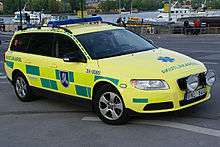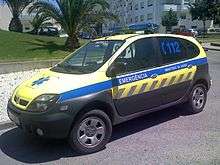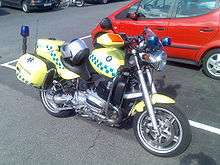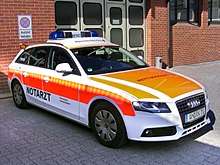Nontransporting EMS vehicle
A nontransporting EMS vehicle, (also known by a variety of local names including fly-car and variations on response vehicle), is an emergency medical service (EMS) vehicle that responds to emergencies, but is not designed to transport a patient. For patients whose condition requires transport (e.g. to a hospital), an ambulance is necessary.

Non-transporting response vehicles (transport refers to the ability to transport a patient on a stretcher) are used for a variety of reasons, including economic, supervisory, and logistical (see Purpose, below). In some cases they may fulfill other duties when not participating in EMS operations, such as policing or fire suppression.
Vehicle types
Non-transporting EMS vehicles come in many sizes and types, from bicycles and golf-carts that can access pedestrian walkways; to motorcycles that are able to fit through stopped or slow traffic; to sedans, station wagons, vambulances (vans), and SUVs that can carry almost as much equipment as an ambulance; to fire engines that carry large crews and may carry specialized equipment. Essentially, any vehicle that lacks the ability to transport a patient may be used, depending on the needs of the local EMS system.
Purpose

A non-transporting EMS vehicle can help emergency medical organizations use their resources more efficiently, assessing an incident's severity (especially where there is reason to suspect the injury or illness is not serious) and either treating the patient at the scene and then releasing them or calling in additional help if required. This saves resources on several levels, as most non-transporting vehicles cost much less than full-size ambulances, and because they may be staffed by a single person (ambulances require a minimum of two crew members: a driver and an attendant). Non-transporting vehicles may be used by supervisors, who may need to move between calls to complete their supervisory duties, or by more highly or specially trained medical providers (e.g. a physician or pain-management technician versus an emergency medical technician), saving those with higher or specialized training from being ensnared in calls that can be capably handled by responders with a more basic level of training.
Non-transporting vehicles can also be used to improve response times. In areas such as busy roads, smaller nontransporting vehicles are able to move through traffic faster than full size ambulances can. Some non-transporting vehicles may also have off-road capabilities, giving them access to areas that traditional ambulances cannot reach. Golf carts and similar vehicles provide access to grassy areas and inside large buildings, such as shopping malls.
Fielding multiple non-transporting vehicles may enable the EMS system to increase the number of units it has available to respond without the greater costs (money and personnel) associated with full-sized ambulances. Adding EMS capabilities to preexisting police cars or fire engines yields similar results.
Examples


Several European countries, such as Germany, Belgium and Austria, with physician-led emergency services, there are Emergency Physician Rapid Response Cars (in German called NEF from NotarztEinsatzFahrzeug—Notarzt = Emergency Physician, Einsatz = Mission, Fahrzeug = Vehicle), staffed with at least an emergency physician and a paramedic. These physicians are generally only called out to serious calls to coordinate multiple ambulances or provide intense on-scene care to serious or critical patients; paramedics and EMTs in ambulances generally can handle most calls by themselves.
In the Swedish medical system, a non-transporting vehicle (akutbil) can be equipped with a nurse specialized in anesthesia who is specialized in pain management, paired together with a paramedic. These vehicles can be staffed around the clock or during the busiest hours of the day and week in order to augment the capacity of the prehospital care provider and can respond both independently and in conjunction with one or more ambulances, air ambulance(s) and other emergency services. As a result of new (circa 2013) legislation requiring all ambulances to be equipped with at least one trained nurse, non-transporting vehicles have become less common.[1][2]
In Belgium, a non-transporting vehicle (called Mobiele Urgentiegroep (MUG) in Dutch, Service Mobile d' Urgence et de Réanimation (SMUR) in French) is equipped with at least one emergency physician and one nurse specialized in intensive and emergency care. Standard Belgian ambulances only have EMTs and/or nurses on board and only provide basic life support. Non-transporting vehicles are only sent out for serious emergencies like drug overdoses and cardiac arrests and provide advanced life support on top of the services provided by ambulance crews.
In France, emergency medicine is generally handled by two services, the Fire Department red ambulances which provide basic life support, and Hospital-based yellow or white vehicles who provide advanced life support ambulances and emergency physicians who use fly-cars. French doctors have been known to remain on scene for extended periods of time to attempt all procedures short of surgery to increase the health of their patients as much as possible prior to transport.
New York City added EMS capabilities to many of their fire engines, effectively adding dozens of responding EMS units without having to purchase or staff additional ambulances. This practice has spread to many Fire Departments across North America.
Hatzalah in New York City, a Jewish volunteer EMS, runs a two-tiered dispatch model where EMTs and paramedics respond to a call in their fully equipped private vehicles acting as NYS-certified fly cars, while an ambulance is brought for transport if necessary.[3] This allows them to maintain response times of " 2 1/2 to four minutes, compared with the city's 911-dispatched median arrival time of about nine minutes"[4] with many fewer transport units.
Similarly in Israel' Magen David Adom, and other EMS organizations utilize motorcycles as non-transporting EMS vehicles to reach patients.
A well-known fictional example of a non-transporting vehicle in the United States is Squad 51 from the 1970s era television series, Emergency!. It is based off the real-life LA County FD Paramedic Squad vehicle, which carries technical rescue as well as emergency medical equipment. LACoFD continues to use this system today.
See also
| Wikimedia Commons has media related to Rapid response vehicles. |
References
- "Stockholms akutbilar". Ambulansforum.se. Retrieved 2013-10-26.
- "Chevra Hatzalah Volunteer Ambulance Corps, Inc". www.hatzalah.org. Retrieved 2017-01-13.
- "Chevra Hatzalah Volunteer Ambulance Corps, Inc". www.hatzalah.org. Retrieved 2017-01-13.